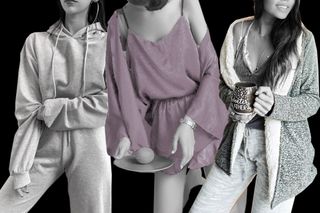
Loungewear as ‘Aesthetic’ Is a Symptom of Constant Self‑Optimization
Needing women to be constantly presentable, even when in private and at rest is symptomatic of societal failure.

Playboy editor-in-chief and noted creep Hugh Hefner spent a significant part of his life cultivating his image as a man who likes to relax. He always wore black silk pajamas, switching to colors at night, and a red, silk smoking jacket when people visited. The multiple beautiful women who lived with him as girlfriends — also known as Playboy Bunnies — all wore identical pink pajamas to bed. Pink flannel, of course, because what better fabric to signify the youth and vitality of young women gathering for a mass orgy than the one that brings to mind cozy sleepwear from one’s childhood?
Gross behavior notwithstanding, Hefner is also remembered for a lifestyle of luxuriating in rest and relaxation. His ‘Bunnies,’ however, didn’t have any control over what they chose to rest in — because they were dressed for his consumption only. The strange bit is that this dichotomy is now replicated in women’s minds, even when nobody’s watching. Women have internalized being watched and judged by the male gaze so much that it is now a pivotal part of their subconscious voice. Plus, due to both the sheer variety of luxury loungewear available and the global obsession with aesthetically pleasing self-care rituals, lounging now comes packaged with the need to look ‘good,’ infecting an act of rest with worry and insecurity.
People should associate what the body wears at rest with feeling safe, content and relaxed. The need to optimize oneself while at rest converts the sacrality of repose into labor. In an attempt to feel good, an individual makes the effort to look good — but then ends up mainly stressing about whether they look good enough, or if there are ways to look better, making the process of optimization never-ending, and in this case, completely pointless. When there is already a certain set standard for attractiveness in place, coupled with a never-ending barrage of choices, there’s a greater likelihood of falling down that rabbit hole — which is why dressing and looking perfect at leisure is mainly a woman’s burden.
Related on The Swaddle:
The Commercialization of Self‑Care Has Left Us Needing More Self‑Care
Soozie Jenkinson, head of lingerie design at Marks and Spencer, defines contemporary loungewear as “super-soft fabrics layered in contemporary yet easy silhouettes.” Loungewear was initially homemade and influenced by climate and prudery. With the invention of the sewing machine, shapeless attire slowly morphed into more structured gowns, with figure-hugging silhouettes and lace trimmings and embroidery overcoming old English prudery to become sleepwear mainstays. The femininity of women’s loungewear is naturally sexualized — it must be soft to touch, a tease to look at and the last frontier for lustful men, rather than garments for women’s rest. Thus the wispy chemise, the delicate négligé, and the elegant slip dress are more likely to come to mind while thinking of women’s loungewear, rather than utilitarian pajamas and warm fleece robes.
However, contemporary loungewear, and how it has influenced outerwear, is a function of a behemoth trend-driven fashion industry slowly inching towards providing comfortable clothes to its consumers. This evolution is marked by women depicted in states of less traditionally put-together relaxation — in pajamas, loose men’s T-shirts, and most importantly, athleisure.
In an essay published in The Guardian from her book Trick Mirror, Jia Tolentino writes, “Men wear athleisure, but the idea and the vast majority of the category belongs to women. It was built around the habits of stay-at-home mums, college students, fitness professionals, off-duty models — women who wore exercise clothing outside an exercise setting and … have heightened reasons to monitor the market value of their looks.”
However, the optimized clothing expects the wearer to be optimized, too. Athleisure, consisting mainly of skin-tight leggings and tank tops, is comfortable workout gear worn outside the gym that still expects the wearer to adhere to a gym-goer’s body. Chip Wilson, the founder of the famous athleisure brand Lululemon, confirmed this when he famously said, “Some women’s bodies just actually don’t work in the pants.” If off-duty utility wear — the stuff you wear for a grocery run — needs women to look good, how are they to relax or do chores in them without the exhaustion of wondering if they look good enough?
Athleisure isn’t the only form of loungewear that expects you to adhere to a standard to fit an aesthetic. Even ‘casual’ loungewear like pajamas and robes, or even a loose T-shirt, expects the wearer to look small against the oversized fabric to fit the aesthetic of a chill woman at leisure — defeating the point of being at leisure.
Related on The Swaddle:
A to Z: A Concise Dictionary of Unfeminist Fashion
The consumption of oneself as a constant aesthetic, to seek grace and elegance even when at rest, is all-consuming. In her essay for Racked, Richa Kaul Padte is disillusioned when trying to emulate an online community of chronically ill women who were also impossibly lovely and put together.
She writes, “I bought the caftans [the women online often wore] seeking an aesthetic of grace — soft, flowing, dignified — but what I was actually after was Grace itself. I wanted a way to grant my body and mind what I no longer believed they deserved: a pardon. I wanted a way to grant my body and mind what I no longer believed they deserved: a pardon. The only problem was, I’d started to secretly hate the caftans. Come Indian summer or British rain, I have always been a shorts kind of girl, and the further I moved away from my denim hot pants, the more disoriented my illness made me. Instead of escaping into the deceptively comfortable world in which the internet’s sick girls lived, I was sinking deeper into my illness, drowning under patterned, pure cotton layers.”
Here, even the state of rest without choice requires optimization to the point where it leads to double the exhaustion and not enough of the elegance promised. Social conditioning and second-guessing oneself as we present to society is life as everyone knows it, but doing the same when all alone with nobody to judge is brainwashing.
Knowing or unknowing of the above, the illusion of the supine, lounging woman clad in the most delightful lace, satin and silk confections persists as a being of beauty and joy, the ideal that women must hustle at work to come home to, and then hustle at rest to keep the illusion afloat.
Aditi Murti is a culture writer at The Swaddle. Previously, she worked as a freelance journalist focused on gender and cities. Find her on social media @aditimurti.
Related


Peripheral Vision: a Bar Housekeeper
